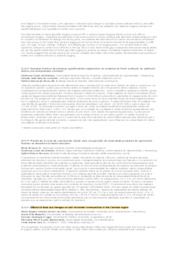Effects of land use changes on soil microbial communities in the Cerrado region.
Effects of land use changes on soil microbial communities in the Cerrado region.
Autoria: SILVA, M. R. S. S. da; BRESOLIN, J. D.; KRUGER, R. H.; BUSTAMANTE, M. M. C.; REIS JUNIOR, F. B. dos
Resumo: The composition and activity of soil microbial communities largely determine biogeochemical cycles, the turnover process of organic matter, and the fertility and quality of solis. Plant communities can influence associated soil microbial communities through the types and amounts of C and nutrients inputs by altering the temperature and water content of the soil. The intensification of agricultural activities in the Cerrado region (savannas of Central Brazil) results in the replacement of native vegetation cover, changes in fire regime and soil physical and chemical properties. As most of soil microorganisms cannot be characterized by conventional cultivation techniques, after soil DNA extraction we used DGGE (Denaturing Gradient Gel Electrophoresis) to investigate soil microbial communities through the comparison of band patterns. Soil samples were taken from 0-5 cm depth in native Cerrado areas (campo sujo and cerrado restricted sense) and in pasture areas. The burned and unburned plots of the two native vegetation types were sampled 2, 10 and 30 days after burning. The samples were collected during the wet and dry season as well as during the transition wet to dry season. Soil DNA was obtained by direct DNA extraction and was amplified by PCr using 16S primers, U968f and L1401r. The comparison of band patterns (amount, position and intensity of bands) indicates significant differences between native and pasture sites and between seasons (wet and dry) and between unburned native áreas.
Ano de publicação: 2004
Tipo de publicação: Resumo em anais e proceedings
Unidade: Embrapa Cerrados
Palavras-chave: Cerrado soils, Land, Microbial communities
Observações
1 - Por padrão são exibidas publicações dos últimos 20 anos. Para encontrar publicações mais antigas, configure o filtro ano de publicação, colocando o ano a partir do qual você deseja encontrar publicações. O filtro está na coluna da esquerda na busca acima.
2 - Para ler algumas publicações da Embrapa (apenas as que estão em formato ePub), é necessário ter, no celular ou computador, um desses softwares gratuitos. Sistemas Android: Google Play Livros; IOS: iBooks; Windows e Linux: software Calibre.
Acesse outras publicações
Acesse a Base de Dados da Pesquisa Agropecuária (BDPA) para consultar o acervo completo das bibliotecas da Embrapa.

